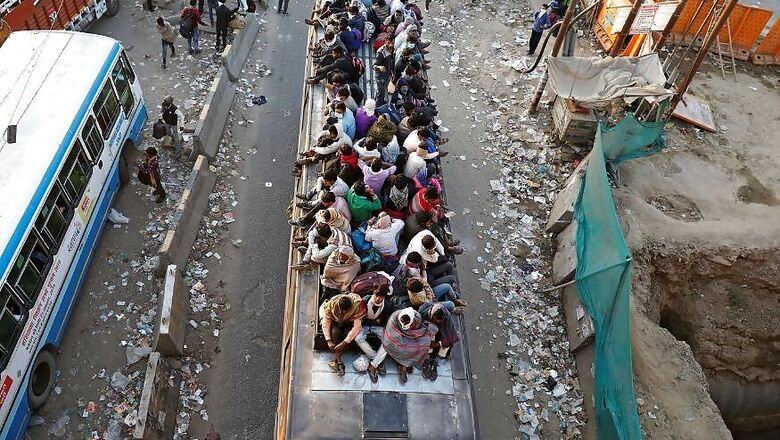
views
Interstate migration for better employment, better wages and better standard of living has been an integral part of the humdrum existence of millions of landless and assetless rural poor for generations.
Per se not objectionable, it becomes highly objectionable when it is associated with deceit and fraud, chicanery and manipulation, exploitation and expropriation, the instinct to rob others of their freedom, barest minimum needs and choice of alternatives in the matter of employment and remuneration.
Viewed in this sense, distress migration becomes coterminous with human trafficking and bondage with infinite misery and suffering. On a modest estimate, over 300 million people in India have been on such a move for ostensible reasons for several years. Of them, at least 10% will be victims of interstate distress migration, many of whom will be victims of trafficking, unfreedom and bondage.
The pockets from where families predominantly migrate as also the pockets to which they migrate have been empirically studied and documented.
Pockets from where families predominantly migrate are:
Uttar Pradesh
Banda.
Balia
Basti.
Deoria
Ajamgarh.
Gorakhpur
Jaunpur
Mirzapur.
Sonbhadra
Bihar
Nawada.
Lakhisarai.
Sitamarhi.
Nalanda
Jharkhand
Palamau.
Chatra.
Pakur.
Gadwa.
Deogarh
Madhya Pradesh
Sehore.
Sahadol.
Betul.
Raisen.
Vidisha.
Satna.
Rewa.
Sidhi
Chhattisgarh
Durg.
Rajnandgaon.
Raigarh.
Raipur
Bilaspur
Mahasaamund
Rajasthan
Barmer.
Jaisalmer.
Jalna.
Sikar.
Jhunjhunu.
Jodhpur.
Bikaner.
Banswada
Odisha
Kalahandi.
Balangir.
Koraput.
Sundargarh
The areas to which they migrate are:
- Andhra Pradesh;
- Karnataka;
- Kerala;
- Punjab;
- Haryana;
- Jammu and Kashmir;
- NCT of Delhi;
- Maharastra;
- Gujarat.
The establishments, occupations and processes where they are recruited by unscrupulous middlemen with a lot of hopes and promises and on receipt of undocumented advances are:
- Brick kilns;
- Stone quarries;
- Leather and salt manufacturing units;
- Zari and zardozi making units;
- Carpet manufacturing units;
- Handlooms, handicrafts, powerlooms and other textile manufacturing units;
- Gem cutting and gem polishing units;
- Diamond cutting and diamond polishing units;
- Quartz cutting and polishing units;
- Bt cotton units;
- Building and various other construction units.
In the wake of the Covid-19 pandemic, which has since December 2019 affected over 6 million people in 193 countries and delivered a deadly blow to the global and national economy, crippled families and ruined the lives of millions of people, multiple and simultaneous planned, coordinated, convergent and concerted efforts have been made to save the economy, lives and livelihood of millions of people: both indigenous and migrants.
Reverse migration has been one of the ways to save the lives of people placed in a terrible situation involving dislocation of home and family life, loss of livelihood due to closure of a large number of manufacturing and non-manufacturing units in which they were hitherto employed.
This means bringing back a large number of interstate migrants who have been placed in a hopeless situation of dislocation, disadvantage and death to their native soil both by special trains and buses at the cost of the state, sanitise and quarantine them, screen and test them for the novel coronavirus, arrange for their hospitalisation and treatment, wherever necessary, and after recovery send them back to their hearth and home.
So far so good. It's a different matter that the same treatment could as well have been extended by the government of the destination state. But for obvious reasons, partly administrative, partly logistics, partly linguistic, but largely socio-cultural (Poorvanchali migrants, as they are often euphemistically called wanted to run away from the NCT of Delhi for their hearth and home partly out of fear but largely out of concern for the safety of the life and limb of their family members; in Bengaluru, capital of Karnataka, the chief minister and state government have succeeded in persuading 6,000 migrant Bihari labourers to stay back with full assurance of protection of their livelihood and income) all destination state administrations have not succeeded in persuading and retaining the interstate migrant workmen.
This notwithstanding, the care and concern, the patience and fortitude and the humanitarianism with which the entire initiative has been taken by the few originating state governments like Odisha, Bihar, Chhattisgarh, Jharkhand and Rajasthan are timely and commendable. The care and concern, the urgency and seriousness shown by the destination state governments of Andhra Pradesh, Karnataka, Kerala, Tamil Nadu, Maharastra and Gujarat in arranging special trains and buses in coordination with the railways and road transport authorities for smooth, safe and orderly transportation of a large number of interstate migrants are equally commendable.
The key questions that remain unanswered are:
- Before migration they were landless. Will enough efforts be made to remove their landless status by allotting at least one hectare of cultivable land per family for the purpose of agriculture, develop the land and make it more productive by providing all necessary inputs (seeds, fertilisers, pesticides, agro-chemicals etc), training and visit, forward and backward linkages?
- Will a plot of homestead land be allotted so that families who are landless and houseless can have a roof above their head by generous assistance under PM Awas Yojana?
- They migrated in search of better employment and wages. At a time when both the global and national economy have suffered a terrible setback, what avenues of stable and durable wage employment with an opportunity for stable earnings and for leading a decent livelihood can be created for them?
- With the present allocation of funds and the number of man-days generated, will the employment under MGNREGA works be sufficient for fulfilling the norms of International Labour Organisation (ILO) convention 122 of 1964 which India ratified in 1997 (the goal of full, free, productive and remunerative employment) or the same would need to be supplemented by additional avenues?
- For self-employment, it is imperative that there is full and need-based access to (a) skill (b) credit (c) technology (d) market without procedural hassles. Will it be possible to provide sufficient avenues of self-employment conforming to the skills and endowments of all interstate migrant workmen who have been brought back to the originating state so that with sufficient incremental income from the avocations/enterprises in which they are engaged there will be less occasion or motivation to migrate once again under the same exploitative conditions as before?
While the government of India and state governments of Bihar, Chhattisgarh, Jharkhand, Odisha and Rajasthan have demonstrated exemplary sensitivity to the plight and predicament of lakhs of interstate distressed migrant workmen and taken timely initiative and action to have them repatriated, the unfinished tasks in the direction of long-term and full social and economic rehabilitation for leading a life of dignity, decency, equality and freedom, which is the quintessence of Article 21 of the Constitution, remain to be attended to with a full sense of urgency and seriousness of concern.
If this is not attended to with the same amount of political will, commitment and determination which propelled and drove the originating state government to bring back the victims of an unprecedented crisis, the well-intended beneficiaries of reverse migration will be unintended victims of poverty, unemployment , hunger, starvation, malnutrition and the immensity of human tragedy accompanying them.
















Comments
0 comment